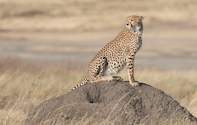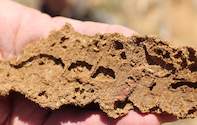
Some writers have used the metaphor of sweeping drama to describe the great migration, with the millions of migrating animals constituting the dramatis personae - and it is a good one.
Let us say it is a Shakespearean play, in which a lion plays the king. But as with all of Shakespeare's historical dramas, the king will be the target of much treason and treachery.
These vast plains are book-ended by hills, the remnants of volcanoes that line the Great Rift Valley and which blew their tops between ten and five million years ago. Successive ash clouds settled to create a thick mantle of deep, rich, soil with only occasional granite koppies, or heads, protruding.
It is a fact that in the Serengeti insects (and the attendant insectivores) way outnumber the herbivores and none are more apparent than the ‘flying ants' which erupt from the ground after rains, providing a feast for any and everything that eats insect protein: birds and baboons, mongooses and warthogs. These so-called ants are in fact termites that must fly in order to attain sexual maturity.
The Secret Lives of Termites

The combined biomass of termites exceeds that of all the animals above the ground. Most of them spend their entire lives in the tunnels and caverns of the termiteria underground, busily processing grass. They cannot digest the hard cellulose in the grass directly but tend fungus farms where the grass is broken down into simple sugars, and then the termites feed on the fungus.
In the early 1900s it was the South African naturalist Eugene Marais who first uncovered the secret lives of termites - literally, by following their trails at night with candlelight, beneath the wooden floors of his farmhouse to astonishing depths underground. In 1923 his research was published in his book The Soul of the White Ant.
In it he recounts how the huge queen termite directs the various classes of termites within the colony to different tasks: soldiers to defend them against marauding ants, workers to collect plant material, another class of workers to tend the fungus gardens.
There is one group of these curious subterranean insects that takes up positions around the queen. When they change their pattern it seems that various messages go out through to the colony to direct the work that is to be done.
But even more numerous are the cleaning-up staff, the decomposers. Not only are there the very visible and much-maligned hyenas and vultures, but also more importantly there are the invertebrates - beetles, blow fly larvae and the most prolific eaters of all, bacteria.
As much as it is a place of overwhelming life, the Serengeti is a place of relentless death. Ashes to ashes you might say.
By David Bristow

 Serengeti National Park Safari Lodges in Tanzania. The Serengeti National Park lies in northwestern Tanzania. See Serengeti National Park sa...
Serengeti National Park Safari Lodges in Tanzania. The Serengeti National Park lies in northwestern Tanzania. See Serengeti National Park sa... The Serengeti is the largest National Park in Tanzania, and one of Africa's premier game parks.The Serengeti plains are the setting for the ...
The Serengeti is the largest National Park in Tanzania, and one of Africa's premier game parks.The Serengeti plains are the setting for the ...